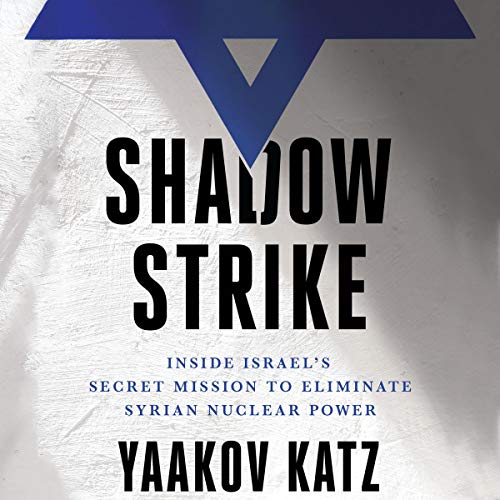BESA Center Perspectives Paper No. 1,253, August 13, 2019
EXECUTIVE SUMMARY: Jerusalem Post editor Yaakov Katz probably had no way of knowing that this would be the perfect time to release a book detailing Israel’s mission to wipe out Syrian nuclear power. Or did he?
The world’s attention is once again riveted to the nuclear threat from Iran, generating kaleidoscopic theories about a potential military strike to disable Tehran’s program. Yaakov Katz’s case study of the run-up to and implementation of the Jewish state’s clandestine destruction in 2007 of Syria’s nuclear program, Shadow Strike – Inside Israel’s Secret Mission to Eliminate Syrian Nuclear Power (St. Martin’s Press), is now a must-read.
Katz flexes both his editorial sinews and government connections (he is a former senior policy advisor) to deliver a suspenseful chronicle, bolstered by a precise, rapid-fire delivery and continuous in-the-room details. This volume will certainly be consulted time and time again by military theorists and diplomatic observers who wonder how a mission like this might be accomplished – in case it needs to be done again.
From the “you are there” opening scene, which details Mossad Chief Meir Dagan’s White House presentation on the Syrian threat, the reader is put on notice to pay close attention. Never failing to paint in the details, Katz skillfully surrounds each personality in the story with a rich biography and a functioning profile within the story’s time frame.
For example, in Chapter 3, when introducing Israeli security cabinet official Rafi Eitan, the author makes sure we know that Eitan is more than just a functionary taking notes – he did a few other things, such as capture Adolf Eichmann. He was the man who visited an American reactor when 200 kilograms of highly enriched uranium disappeared and (perhaps – who knows?) found their way to Israel’s ambiguous nuclear program in Dimona. Eitan also worked ground operations against the PLO in Lebanon, and recruited and managed Israel’s infamous spy inside the American naval establishment, Jonathan Pollard.
This type of in-depth storytelling and character-building courses throughout Katz’s superb volume. Readers are enveloped in more than historical facts. They are transported inside the tense, unfolding world of personalities, events, clashes, countdowns, and decision-making that resulted in the successful Syrian takedown.
So intense is the detailing of the decision process that the actual bombing of Syria’s reactor is but briefly reported in a few paragraphs as an ipso facto of the narrative.
It might be tempting to conflate the 2007 Syrian challenge with the current Iranian crisis, but they are not directly analogous. Syria was only taking preliminary steps toward nuclearization. Iran, by contrast, has the essentials for a nuclear bomb that can be assembled and deployed within weeks, according to many experts. It is as well to face the details of this reality head-on.
Tehran’s endless centrifuge arrays have spun off sufficient 99% highly enriched uranium to be compressed into an unstable and dense core. That core, encased in an R-265 Shock Generator configured in a bifurcated sphere lined with 5mm grooves filled with PETN explosive, would be ignited with microsecond precision to create a synchronous implosion that would be absorbed by an exploding bridgewire. The massive implosion force would trigger a neutron initiator to fire one particle into the warhead core to create an atomic chain reaction that would clap forth a murderous mushroom cloud.
Bear in mind that Iran is also able to deliver this payload. It has developed a fleet of mobile Shahab-3 missiles derived from the North Korean No Dong, each with a nosecone large enough to carry a nuclear warhead. Tehran possesses the flight guidance and ignition control to detonate such a warhead 550 meters above the ground – mimicking the bombing of Hiroshima – which would unleash a ferocious nuclear inferno. Iran recently test-fired a Shahab-3 as a reminder that it knows how to pull the trigger.
Iran also wields a Russian S-300 missile defense system fully capable of protecting its nuclear program and strike assets.
When reading Katz’s book, remember that as complex and difficult as the Syrian strike was, any similar strike on Iran’s nuclear capability would be infinitely more daunting and risky. If such a decision is made, the men and women who make it will stand on the shoulders of those who knocked out Syria’s facility – but they will be reaching for a much higher and more perilous bar.
Katz’s mastery of the facts and relentless assemblage of puzzle pieces, together with his knowledge of the players and the potentialities, make Shadow Strike a powerful read. The volume also demands that Katz write another. No one knows if such a sequel will chronicle yet another shadow strike upon another nation to the east.
Edwin Black is the award-winning New York Times bestselling author of IBM and the Holocaust and the journalist who revealed the design specifics of Iran’s nuclear warhead.


